|
Every aspect of Moraff's MahJongg is completely customizable and can be used to create thousands of game combinations. Use these options to create and save an unlimited amount of new mahjong solitaire game variations!
Choose a Layout:
From the Game ribbon, choose Layouts. This will open the Layout Browser that provides a thumbnail view of all available tile layouts. Select a layout and click View to see a larger image of it. To use a layout, click a thumbnail on the right to select it and then choose OK. Double-clicking a layout will automatically load it onto the game board. Changing the layout will cause the current game to restart.
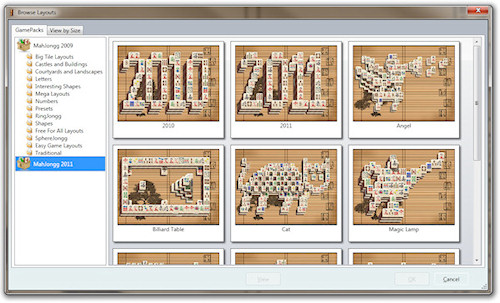
Hint: Looking for a specific amount of tiles to play? Choose the View By Size tab on the Layout Browser!
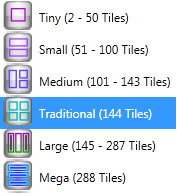
Choose a Tileset:
From the Theme ribbon, choose Primary Tileset. Clicking this will bring up the Browse Primary Tilesets dialog. Tilesets are grouped by GamePack on the left side of the dialog. Choose a new tileset thumbnail on the right side and click OK to load it into the current game. Double-clicking the tileset will also load it into the current game.
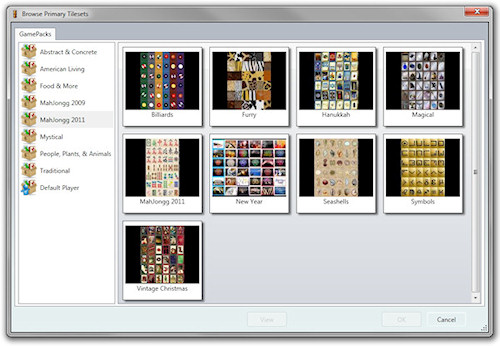
The Secondary Tileset option on the Game ribbon will only be seen if a layout larger than 144 tiles has been chosen to play and the number of matches in the Game Rules is set to two. Secondary Tilesets are chosen the same way Primary Tilesets are chosen
Hint: Want to use the same tileset instead of two different ones for a Layout with more than 144 tiles? Go to the Game ribbon and choose Rules. Increase the Number of Matches to 3 or more and the game will then be able to use a single Tileset in a Large or Mega Layout.
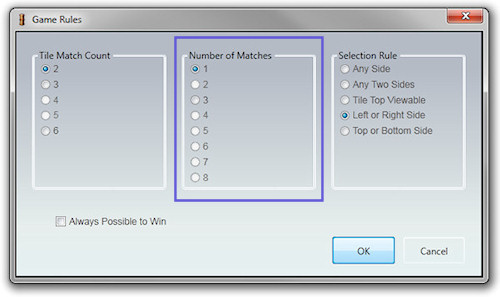
Choose Tile Height:
From the Theme ribbon, click Tile Height. This displays the Tile Height options. These are used to adjust the height of the tile's side and bottom. They are percentages of the tile face's width and height.

Choose Shadow Lengths:
From the Theme ribbon, click Shadow Length. This displays the Shadow Length options. These are used to adjust the length of the shadows cast by the tiles. They are a factor of the tile's side width and bottom height.

Choose a Background:
From the Theme ribbon, choose Backgrounds. Clicking this will bring up the Browse Backgrounds dialog. Backgrounds are grouped by GamePack on the left side of the dialog. Choose a new background thumbnail on the right side and click OK to load it into the current game. Double-clicking the thumbnail will also load it onto the game board.
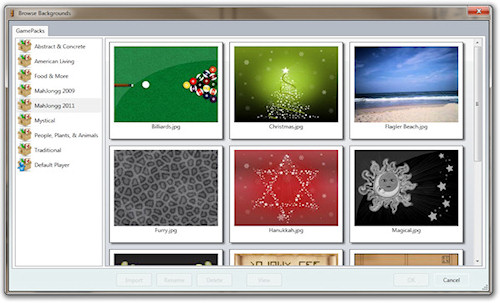
Hint: Want to use a solid color for the background instead of an image? Go to the Player ribbon --> Preferences --> Background and uncheck Show Background Image. Then use the color picker to choose a color!
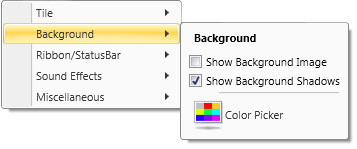
Choose Game Rules:
From the Game ribbon, choose Rules. This will open the Game Rules dialog.

- This choice is how many tiles will be required for matching before they are removed from the game board.
- This is how many sets of matches are in play for each tile. For instance, if this is set to 2 and the tile match count is set to 3, there will be 2 sets of 3 matching tiles in game play. Increase this number to 4 or more to use one tileset in a Mega (more than 144 tiles) layout. Black Ice Mega-MahJongg and Painted Tiles Mega-MahJongg are examples of this.
- This determines which tiles are available for selection.
- - If any of the four tile sides is open, the tile will be in play.
- - Requires that any two sides be open for the tile to be selected.
- - If the top of the tile can be seen fully, the tile can be played.
- - Requires that either the left or the right side of the tile to be open for the tile to be used in play. This is the choice for a traditional game of solitaire mahjongg.
- - Requires that either the top or the bottom side of the tile to be open for the tile to be used in play.
- Selecting this will ensure that every layout becomes winnable. Note: this does not guarantee that the game will be won. Winning still depends on the user's choice in which tiles are removed at what time.
Hint: Want a very easy game? Choose Tile Top Viewable and every tile whose top can be seen can be selected!
Choose Cursors:
From the Theme ribbon, choose Cursors. This displays a drop down where you can choose which type of cursor to change.
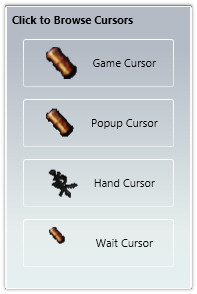
- - This is the cursor that is used for all game play and menu selections.
- - This cursor is displayed on links.
- - When a tile is available for game play according to the currently set rules, this cursor will appear.
- - When loading dialogs or any in-game wait time is necessary, this cursor will appear.
Clicking any of the options opens the Browse Cursors dialog. Cursors are grouped by GamePack on the left side of the dialog. Choose a new cursor thumbnail on the right side and click OK to load it into the current game.

Hint: Want to always use a Windows cursor instead of custom game cursors? On the Player ribbon --> Preferences --> Miscellaneous, uncheck Enable Game Cursors.
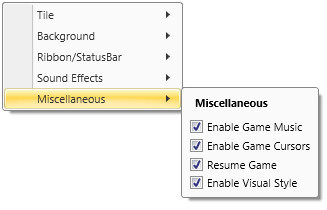
Choose Music to Add to the Playlist:
From the Theme ribbon, choose Playlist. This displays the Music Playlist dialog which allows music to be added, removed, and moved up and down in the current playlist.
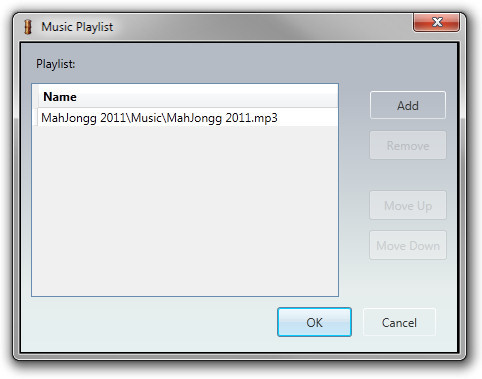
Clicking Add brings up the Music Browser which shows all music selections in all currently installed GamePacks.

Music files are grouped by GamePack on the left side of the dialog. To hear the music before selection, click the Play button for each file. Choose a new music file on the right side and click Add to add it into the current playlist. To select multiple files at once, use the Ctrl key
Hint: Want a to turn off the music permanently? Go to Player ribbon --> Preferences --> Miscellaneous, and uncheck Enable Game Music.

Choose Sound Effects:
From the Theme ribbon, choose Sound Effects. This displays the Sound Effects dialog.
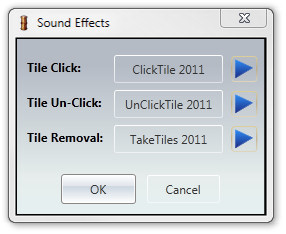
- - This is the sound effect that plays when a tile is clicked. To change this option click the button showing the currently loaded sound and the Sound Effects Browser will open. To hear the current choice, click the Play button. If this button is disabled then the Sound Effects preferences for it are un-checked in player preferences.
- - This is the sound effect that plays when a tile is un-clicked. To change this option click the button showing the currently loaded sound and the Sound Effects Browser will open. To hear the current choice, click the Play button. If this button is disabled then the Sound Effects preferences for it are un-checked in player preferences.
- - This is the sound effect that plays when a tiles are removed from the game board. To change this option click the button showing the currently loaded sound and the Sound Effects Browser will open. To hear the current choice, click the Play button. If this button is disabled then the Sound Effects preferences for it are un-checked in player preferences.
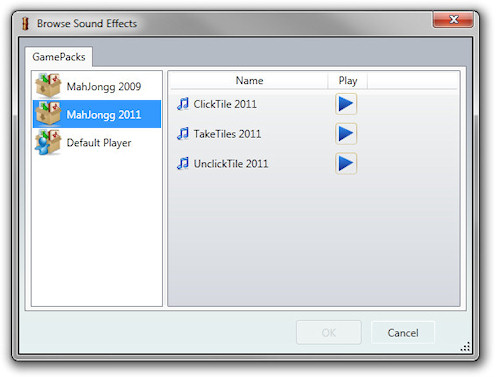
Sound Effects are grouped by GamePack on the left side of the dialog. Click Play next to each sound effect to try it out before choosing it. Choose a new sound effect on the right side and click OK to load it into the current game.
Hint: Want a to turn off some or all of the sound effects permanently? Go to Player ribbon --> Preferences --> Sound Effects, and choose your preferences.
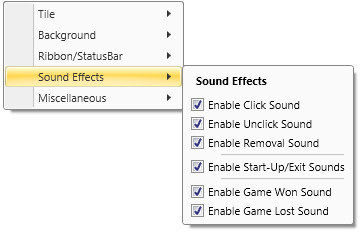
Choose Game Styles:
From the Theme ribbon, choose Styles. This dislays a drop-down of options that changes the game skin to the choices listed. Obsidian is the default skin the game uses.

- Brings up a color picker that allows the user to choose a standard or custom color to use for the game's style. The color chosen through this color picker will build on the preset style already in use.
Hint: Want a to turn off game styles? Go to Player ribbon --> Preferences --> Miscellaneous, and uncheck Enable Visual Style.

Don't Forget to Save:
From the Game ribbon, choose Save. This saves the current game configuration into the current player's GamePack folder. All Player saved games can be access by clicking Browse on the Game ribbon and choosing the Player folder on the left.


The game shown here was created using this tutorial. |




















